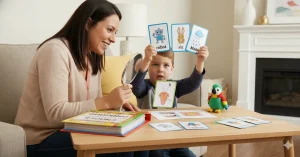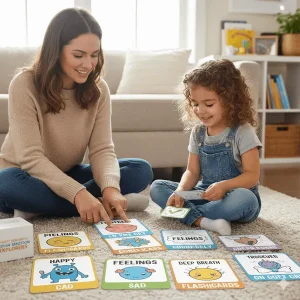The Effects of Tongue-Tie on Articulation: What You Need to Know
Last Updated: August 19, 2025
“Why does my toddler speak, but some sounds still seem unclear?” If you’ve found yourself asking this—or wondering if your child’s tongue-tie and speech delay are connected—you’re not alone. Many parents are surprised to learn that this small fold of tissue under the tongue, known as tongue-tie (ankyloglossia), can sometimes affect how children produce sounds, form words, and develop clear, confident speech.
Tongue-tie and speech issues are more connected than most realize. While not every case leads to problems, in some children, it can contribute to articulation difficulties—especially with sounds that require tongue tip movement like /t/, /d/, /l/, and /s/.
In this blog, we’ll break down:
- How tongue-tie affects speech articulation
- What signs to watch for in your child’s communication
Whether your child has been diagnosed with tongue-tie, or you’re simply exploring why certain sounds are hard for them, this guide will help you understand the speech-language pathologist’s (SLP’s) perspective—and what you can do next to support your child’s voice.
Free Speech Help for Kids
Concerned about speech delays? Book a free consultation with our expert speech therapist and get guidance tailored to your child’s needs.
What Is Tongue-Tie and How Does It Impact Speech?
Tongue-tie, also known by its medical name ankyloglossia, is a condition where the thin band of tissue (called the lingual frenulum) under the tongue is unusually short, tight, or thick. This band connects the bottom of the tongue to the floor of the mouth. While this may sound like a purely anatomical issue, what truly matters—especially for speech—is how that restriction affects movement.
In speech therapy, we look beyond anatomy and focus on function. A child with tongue-tie may have difficulty using their tongue in flexible, precise ways—especially during speech. That’s because certain speech sounds require specific tongue movements that can be limited by a tight frenulum.
Let’s break it down:
Lingual Elevation (needed for sounds like /t/, /d/, and /n/)
To make these sounds, the tongue must lift and touch the roof of the mouth right behind the teeth. If the tongue is restricted, your child may struggle to lift it high enough or may compensate by using the sides or pushing against the teeth—leading to unclear articulation.
Tongue Protrusion (essential for the /th/ sound)
Sounds like /th/ in “this” or “thing” require the tongue to gently extend beyond the teeth. Children with tongue-tie might avoid these sounds altogether or substitute them with others, like turning “thumb” into “fum.”
Also read: Help Kids Master the “TH” Sound: Fun & Easy Tips
Lateralization (important for /l/ and /s/ sounds)
To make a clear /l/ or /s/, the tongue needs to move side-to-side, allowing airflow or contact with specific mouth areas. A restricted tongue may result in slushy, distorted sounds, or even speech that’s harder to understand during conversation.
But Here’s What You Should Know:
Not every child with a tongue-tie develops speech problems. Some children compensate naturally and speak clearly despite the restriction. That’s why it’s essential to look at how your child is using their tongue, not just whether a tongue-tie exists.
An experienced speech-language pathologist (SLP) can assess whether the tongue-tie is affecting your child’s ability to produce sounds clearly and guide you on what steps to take next—without jumping straight to surgery.
Signs Your Child’s Speech May Be Affected by Tongue-Tie
If your child has been diagnosed with tongue-tie (ankyloglossia), or if you suspect it, you might be wondering whether it’s affecting their speech. The truth is, tongue-tie can impact children differently. Some kids speak clearly despite a visible restriction, while others may show subtle or even noticeable speech and oral motor challenges.
Here are some common signs that your child’s speech may be affected by tongue-tie:
Mild to Moderate Speech Sound Errors
One of the earliest red flags parents notice is that their child isn’t pronouncing certain sounds correctly. You may hear things like “tat” for “cat” or “dun” for “sun.” Sounds that require tongue elevation or precise placement, such as /t/, /d/, /l/, /n/, /s/, and /th/, can be especially tricky for kids with tongue restrictions. These aren’t always severe errors, but they can make your child’s speech sound unclear or immature for their age.
Inconsistent Sound Production or Substitutions
Another sign to watch for is inconsistency. Your child might say a word correctly one day, and completely differently the next. For example, “dog” might come out as “gog,” “dah,” or “gawk.” These inconsistent substitutions often happen when children are working around a restricted tongue—finding new, sometimes inefficient ways to say the sounds they struggle with.
This may also indicate a motor planning issue or phonological process, but in the context of tongue-tie, it often reflects the tongue’s limited range or strength.
Drooling or Difficulty With Chewing
While we often focus on speech sounds, tongue-tie can also affect oral motor skills—things like chewing, swallowing, and saliva control. If your child drools beyond toddlerhood or struggles to chew age-appropriate food, their tongue may not be coordinating properly during these tasks.
These challenges might not directly cause speech problems, but they can indicate underlying oral motor issues, which are closely linked to speech development. The tongue isn’t just for talking—it plays a big role in overall mouth function.
Delayed Expressive Language in Toddlers
Some toddlers with tongue-tie are late talkers—not because they don’t understand language, but because producing words is physically harder. If it takes extra effort to move their tongue or form sounds, they may become frustrated and use gestures, pointing, or sounds instead of words.
It’s also common to see shorter sentences, limited vocabulary, or fewer attempts at speech. In these cases, tongue-tie may be a contributing factor to delayed expressive language, especially if paired with unclear articulation.
When to Get Help
If you notice any of these signs—especially if they’re persisting past age 2—it’s a good idea to consult a speech-language pathologist (SLP). An SLP can assess whether your child’s speech patterns are within the typical range for their age or if a tongue-tie is limiting their progress.
Early intervention through speech therapy can make a big difference. And remember, not every child with tongue-tie needs surgery. In many cases, targeted speech therapy can help children learn to speak more clearly by working within their physical abilities.
When Should You Seek a Speech Evaluation for Tongue-Tie?
As a parent, it can be tricky to know when your child’s speech needs extra support—especially if they’re already talking. Many children with tongue-tie do learn to speak, but some may face subtle challenges that aren’t immediately obvious. That’s why the timing of a speech evaluation matters.
Here’s what you need to know about when to involve a speech-language pathologist (SLP) and why it’s a crucial step if you suspect tongue-tie may be affecting your child’s communication.
The Importance of Early Screening by an SLP
The earlier a child’s communication concerns are identified, the better their outcomes tend to be. This is especially true for toddlers and preschoolers, whose brains are in a critical window for speech and language development.
If your child has a visible tongue-tie or you’ve been told they do, don’t wait to “see if they outgrow it.” While some children develop clear speech with no issues, others quietly compensate in ways that affect speech clarity, sound accuracy, or even confidence when speaking.
A certified speech-language pathologist can assess not just how your child talks, but how well they can move and use their tongue for speech-related tasks—such as producing specific sounds, combining words, or even eating and drinking.
Is It an Articulation Disorder—or Something Else?
Parents often wonder: “Is my child just learning at their own pace, or is something more going on?”
An SLP can help differentiate between:
- A true articulation disorder (difficulty forming certain sounds)
- A phonological delay (patterns of sound errors)
- Or a speech issue related to oral restrictions like tongue-tie
For example, if your child consistently struggles with sounds like /t/, /d/, /l/, or /th/, and those sounds require tongue elevation or protrusion, the SLP will explore whether limited tongue movement might be contributing. This professional insight helps guide appropriate therapy and avoids unnecessary treatment paths.
Look at Function, Not Just Fluency
Many children with tongue-tie do talk, and may even have a strong vocabulary. But what matters most is how clearly they speak and how well their tongue is functioning during speech.
Here are some signs that it’s time for an evaluation:
- Your child’s speech is difficult to understand beyond age 2.5–3
- They avoid certain sounds or words
- They get frustrated when trying to express themselves
- They have a visible tongue-tie and unclear speech
- You’ve noticed oral motor concerns like drooling or feeding issues
Remember, it’s not about whether your child is talking. It’s about how they are using their mouth and tongue to communicate. If movement is restricted, they may be working harder than needed to speak—and that can affect long-term communication habits.
Early Support Builds Confidence and Clarity
Speech evaluations are gentlle, play-based, and highly individualized. Your child won’t be judged or compared—they’ll be supported. If therapy is recommended, it will focus on improving speech clarity, sound production, and oral-motor coordination—all tailored to your child’s needs.
Even if no therapy is needed, an SLP can provide peace of mind and simple strategies to support your child’s speech at home.
How Speech Therapy Supports Children With Tongue-Tie
If your child has a tongue-tie that’s affecting their speech, rest assured—speech therapy can make a big difference. The goal isn’t to “fix the tongue,” but to help your child use their tongue effectively for clear, confident communication.
At its heart, speech therapy for tongue-tie is about empowering your child with strategies that work for their individual needs. Every session is designed to be engaging, functional, and developmentally appropriate—especially for toddlers and preschoolers.
Focus on Compensatory Strategies and Oral Awareness
Children with tongue-tie may struggle to make certain sounds because their tongue doesn’t move freely in all directions. Instead of forcing movements that aren’t possible, a skilled speech-language pathologist (SLP) will teach your child how to work around the restriction using compensatory techniques.
This could mean adjusting how they place their tongue, slowing down their speech, or using more oral awareness—understanding what their tongue, lips, and mouth are doing during speech. Helping a child become aware of their mouth movements is often the first step toward improving clarity.
Improving Tongue Coordination for Target Sounds
Certain sounds—like /t/, /d/, /l/, and /th/—require precise tongue coordination. If your child’s tongue has limited range or strength due to a tie, an SLP can introduce exercises and fun activities that help them practice moving their tongue in ways that are possible and productive.
Rather than drilling sounds in a rigid way, therapy focuses on:
- Coordinated tongue taps (for /t/, /d/)
- Lifting the tongue tip gently (for /n/, /l/)
- Controlled airflow for sounds like /s/ or /sh/
These skills are introduced gradually and practiced through play, songs, and games that make learning enjoyable.
Building Phonemic Awareness for Self-Monitoring
Another key goal in speech therapy is helping your child tune in to how words should sound—a skill known as phonemic awareness. When kids start to notice the difference between “tat” and “cat” or “fum” and “thumb,” they’re more likely to self-correct and grow more confident.
This awareness is built through listening activities, sound matching games, and imitation practice. It’s not just about copying the therapist—it’s about helping your child hear, feel, and understand their own speech.
Practicing Sound Placement With Mirrors, Tactile Cues, and Repetition
Young children learn best through visual and sensory feedback. In therapy, your child might use a mirror to watch their tongue movements or touch cues (like a gentle tap under the chin) to help place their tongue in the right spot.
This hands-on, multi-sensory approach helps children:
- Recognize where their tongue is during a sound
- Feel what a correct sound “feels like”
- Repeat sounds in structured, playful ways
Over time, these small adjustments add up to big improvements in speech clarity.
Emphasizing Play-Based Therapy for Toddlers
For toddlers with tongue-tie, therapy isn’t about drills or flashcards—it’s about play. Through songs, stories, pretend play, and movement games, SLPs introduce speech goals in a way that feels natural and fun.
This approach keeps children motivated, relaxed, and open to learning. It also helps generalize skills to daily life, so you start hearing clearer speech during real conversations—not just in therapy sessions.
Speech Therapy Techniques Used for Children With Tongue-Tie
When it comes to supporting a child with tongue-tie and speech difficulties, therapy is not about pushing or forcing movement. Instead, it’s about meeting the child where they are—gently guiding them toward better clarity, coordination, and confidence using proven, child-friendly strategies.
A speech-language pathologist (SLP) uses a variety of carefully chosen techniques based on your child’s unique needs. These methods are rooted in both science and play, helping your child build speech skills at their own pace.
Here’s a closer look at some of the techniques commonly used in speech therapy for children with tongue-tie:
Oral Motor Warm-Ups (As Tolerated—Not Force-Based)
Oral motor warm-ups are gentle movements or activities that prepare the mouth for speech. These include:
- Tongue wiggling side-to-side
- Lifting the tongue to the roof of the mouth
- Smiling, puckering, and lip pops
These exercises help activate the oral muscles, increase awareness of movement, and improve tongue strength and control—as long as they are done in a fun, non-forceful way.
It’s important to note that not all children need oral motor work, and SLPs use them only when appropriate. The focus is always on function, not stretching or straining.
Cueing Hierarchies for Sounds Affected by Tongue Mobility
Some sounds—like /l/, /s/, or /th/—may be harder to produce with limited tongue movement. To help with these, SLPs use cueing hierarchies—a step-by-step method that starts with the simplest support and builds up as needed.
Cues may include:
- Verbal cues (“Lift your tongue tip”)
- Visual cues (using a mirror to show tongue placement)
- Tactile cues (light touch under the chin or on the cheek)
- Gestural cues (hand signs to guide airflow or movement)
These cues help children understand and feel what they need to do, and with repetition, they often become more independent in producing the sound correctly.
Sound Shaping from Easier to More Difficult Positions
Children with speech challenges often benefit from sound shaping—starting with a sound or position they can already do, and gradually modifying it toward a more difficult target.
For example:
- Starting with a strong /t/ (which uses tongue tip elevation) to shape a clear /s/ sound
- Using an easy vowel to ease into a consonant blend
This method builds on what your child can already do, giving them a sense of success while helping them stretch their skills.
Minimal Pairs and Phonological Contrast Therapy
For some children with tongue-tie, the issue isn’t just sound production—it’s how they use and understand sound differences in words. This is where phonological therapy comes in.
Minimal pairs are pairs of words that differ by just one sound, like:
- “top” vs “stop”
- “sun” vs “fun”
By practicing these in playful activities, children learn to hear and produce differences more clearly. This kind of therapy helps reduce sound substitutions or deletions that are common when a child is compensating for limited tongue movement.
Use of Visual Aids, Tactile Feedback, and Modeling
Children learn best when they can see, feel, and hear what they’re trying to do. In speech therapy, we use tools that bring speech to life:
- Mirrors so children can watch their mouth movements
- Tactile feedback like tapping the face or placing a sticker on the tongue to guide movement
- Verbal modeling, where the therapist clearly and repeatedly demonstrates the target sound
These techniques support muscle memory, build self-awareness, and increase a child’s ability to self-correct their sounds over time.
Every Technique Is Tailored to Your Child
Not every child with tongue-tie needs the same approach. A skilled SLP will choose techniques based on your child’s age, speech goals, attention span, and tongue function. What matters most is creating a safe, playful environment where your child feels motivated to try—and proud to improve.
Realistic Expectations: What Progress Looks Like With Therapy
When your child starts speech therapy for tongue-tie, it’s natural to hope for quick results. After all, clear communication is something every parent wants for their child. But as with any kind of developmental support, progress in speech therapy is a journey—not a race.
Understanding what realistic progress looks like can help you stay patient, involved, and confident that your child is on the right path.
Every Child Is Different—Some Respond Quickly, Others Gradually
No two children have the same experience with tongue-tie and speech therapy. Some may make noticeable improvements within just a few weeks of consistent sessions. Others may take several months to master certain speech sounds—especially if they’ve been compensating for restricted tongue movement for a long time.
The key is to trust the process and remember that steady growth matters more than speed. Your child is learning a brand-new way to move their tongue, listen closely to sounds, and build the confidence to speak clearly—and that takes time.
Therapy Doesn’t “Fix” the Tongue—It Builds Functional Clarity
It’s important to know that speech therapy isn’t about fixing the tongue itself. Especially in children with tongue-tie, the goal is not to force the tongue to do things it physically can’t. Instead, speech therapy focuses on:
- Helping your child maximize their speech intelligibility
- Teaching them how to use the range of motion they do have
- Building awareness, control, and coordination through fun, functional activities
Think of therapy as a toolbox for clearer speech. Some children learn to speak clearly with minimal tongue movement by using clever strategies taught by their therapist. Others benefit from building strength and awareness over time through repetition, feedback, and structured play.
Tracking Progress Through Speech Sound Inventories and Parent Check-Ins
Progress in speech therapy is carefully monitored—not just by “how many words” a child says, but by how clearly they say them. Speech-language pathologists often use speech sound inventories, where they track which sounds your child can say correctly and in which positions (beginning, middle, end of words).
You’ll also be involved as a parent through regular check-ins, home practice ideas, and updates on your child’s communication goals. This partnership allows you to see the small but meaningful steps your child is taking each week—even when those steps aren’t always obvious in daily conversation.
With the right support and consistency, many children with tongue-tie learn to speak clearly, confidently, and comfortably.
Progress May Be Slow—but It’s Still Progress
Don’t be discouraged if progress feels slow at first. Clarity develops gradually, especially when a child is learning to coordinate new muscle patterns or break old habits. Celebrate the small wins:
- A new sound said correctly
- Fewer substitutions or errors
- Increased willingness to try new words
Each step is a sign that your child is building a strong foundation for future speech success.
What to Do If You Suspect Tongue-Tie Is Affecting Your Child’s Speech
If you’ve ever wondered, “Is my child’s tongue-tie making it harder for them to speak clearly?” — you’re not alone. Many parents notice speech concerns but aren’t sure when or how to take the next step. The good news is, you don’t have to wait for things to get “worse” to seek help.
Speech clarity matters, even if your child is already talking. Clear communication builds confidence, reduces frustration, and helps your child connect more easily with the world around them.
Here’s a simple step-by-step guide on what to do if you suspect tongue-tie may be impacting your child’s speech:
Step 1: Observe Your Child’s Speech Patterns and Intelligibility
Start by paying close attention to how your child sounds when they speak:
- Do they consistently mispronounce certain sounds like /t/, /d/, /s/, or /l/?
- Are they difficult for others to understand, even if you can follow what they’re saying?
- Do they avoid talking in certain situations or seem frustrated when trying to express themselves?
These can all be signs that their tongue mobility might be affecting speech intelligibility—a term speech therapists use to describe how clearly a person is understood by others.
Step 2: Consult a Certified Speech-Language Pathologist (SLP)
The next—and most important—step is to connect with a licensed speech-language pathologist. An SLP will evaluate both the structure and function of your child’s tongue, as well as their speech patterns, sound production, and communication needs.
This evaluation isn’t just about checking boxes—it’s about understanding how your child’s tongue-tie may (or may not) be influencing their ability to:
- Form sounds
- Combine words
- Speak clearly and confidently
The SLP can also rule out other possible causes of speech delay or articulation issues, ensuring your child gets the right kind of support from the start.
Step 3: Begin a Structured Therapy Plan Based on Individual Needs
If the evaluation shows that your child would benefit from support, the SLP will design a personalized speech therapy plan tailored to their abilities, age, and goals. Therapy may include:
- Oral motor activities
- Sound production practice
- Strategies for self-monitoring
- Play-based learning for younger children
Importantly, speech therapy doesn’t focus on “fixing” the tongue—it focuses on building functional clarity with the movement your child already has. Many children with tongue-tie thrive using compensatory strategies and practice, without ever needing surgery.
Don’t Wait—Early Support Makes a Big Difference
Just because your child is talking doesn’t mean they don’t need support. Speech clarity is just as important as vocabulary or sentence length. If your child is difficult to understand, gets frustrated when speaking, or is being misunderstood at school or daycare—it’s worth exploring further.
Early speech therapy gives children the tools to speak clearly, reduce frustration, and feel confident in social situations. The earlier you start, the easier it is to support their communication milestones and prevent long-term habits from forming.
Conclusion
Tongue-tie can sometimes make it hard for children to speak clearly, even if they are already talking. It may affect how they say sounds or how well others understand them. The good news is that speech therapy can help. A speech-language pathologist can teach your child ways to use their tongue better and speak more clearly—without needing surgery. If your child’s speech seems unclear or delayed, don’t wait. Early support leads to better results. With the right help, your child can feel more confident, be better understood, and enjoy talking with ease every day.
Frequently Asked Questions:
1. Can tongue-tie cause speech delay in toddlers?
Yes, tongue-tie can cause speech delay in some toddlers. When the tongue’s movement is limited, it can make it hard to form certain speech sounds clearly. This can lead to fewer spoken words or unclear speech as your child gets older. However, not all children with tongue-tie have speech delays. If your child is late to talk or hard to understand, it’s a good idea to get them checked by a speech therapist.
2. How do I know if tongue-tie is affecting my child’s speech?
Some signs include unclear speech, skipping or replacing certain sounds, or your child getting frustrated when talking. They might say “tat” instead of “cat” or avoid words with tricky sounds like /l/ or /th/. If other people (not just close family) struggle to understand your child, it may be more than just normal development. A speech-language pathologist (SLP) can evaluate whether tongue-tie is causing the problem.
3. Do all children with tongue-tie need speech therapy?
No, not every child with tongue-tie will need therapy. Some children speak clearly and don’t have any trouble with sound production. But if tongue-tie is affecting speech clarity, sound development, or your child is avoiding certain words, speech therapy can help. An SLP will check how your child speaks and suggest support if needed.
4. Can speech therapy help even if my child has not had tongue-tie surgery?
Yes! Many children make great progress through speech therapy alone. The focus is not on “fixing” the tongue, but on helping your child use the movement they do have to speak more clearly. Therapy teaches strategies like better tongue placement and sound shaping, even when a child still has the tie.
5. What sounds are hard for kids with tongue-tie?
Sounds that need the tongue to move up or out are often harder, like /t/, /d/, /l/, /s/, and /th/. If the tongue is restricted, these sounds might be missing, swapped with others, or sound unclear. For example, “sun” might come out as “fun” or “dun.” Speech therapy helps children learn how to produce these sounds more clearly using the movement they’re capable of.
6. Should I wait to see if my child outgrows tongue-tie?
While some children adapt and speak clearly, it’s better not to wait if you notice unclear speech or frustration. Early intervention can make speech therapy easier and more effective. Waiting too long may allow speech habits to form that are harder to change later. It’s best to get a speech evaluation to know for sure.
7. What age should a child start speech therapy for tongue-tie?
Children as young as 2 years old can start speech therapy if they’re showing signs of speech delay or unclear talking. The earlier therapy starts, the easier it is to build correct speech habits. An SLP uses play-based methods with toddlers, so it feels fun and engaging while helping with speech clarity and tongue control.
8. Will my child talk later because of tongue-tie?
Tongue-tie doesn’t always cause late talking, but it can make it harder to say certain sounds clearly. This may lead to delayed speech, fewer words, or unclear speech in toddlers. If your child talks less than other kids their age or avoids talking altogether, it’s a good idea to get their speech assessed.
9. How long does speech therapy take for tongue-tie?
There’s no fixed timeline—every child is different. Some improve in a few months, while others need longer depending on their age, how much the tongue is restricted, and how often they practice. Regular sessions and home practice help speed up progress. An SLP will guide you with clear goals and updates along the way.
10. Who should I talk to if I think tongue-tie is a problem?
Start by booking a consultation with a speech-language pathologist. They specialize in identifying speech delays and can tell if tongue-tie is affecting your child’s speech. You don’t always need a doctor’s referral to meet with an SLP. Getting early help can lead to better communication and fewer frustrations for your child.
About the Author:
Shravanaveena Gajula
M.Sc ., Speech and Language Pathology (5+ years of experience)
Shravanaveena Gajula is a dedicated Speech-Language Pathologist with a BASLP and an M.Sc in Speech and Language Pathology. With experience spanning multiple settings, including Wellness Hub , Veena specializes in a wide range of disorders from developmental issues in children to speech and language assessments in adults. Her expertise includes parent counseling, managing speech sound and fluency disorders, and creating individualized therapy programs. Veena is also PROMPT certified and an author of several insightful blogs on speech and language pathology, aiming to educate and assist caregivers in supporting their loved ones.
Book your Free Consultation Today
Parent/Caregiver Info:
Client’s Details:
* Error Message









